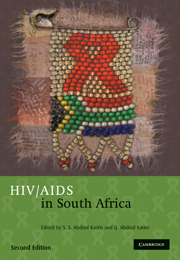Book contents
- Frontmatter
- Contents
- List of Contributors
- Foreword: Peter Piot
- Foreword: Nelson R Mandela
- Acknowledgements
- Section 1 Birth of a rapidly growing epidemic
- 1 Introduction
- 2 Overview of the book
- 3 HIV infection in South Africa: the evolving epidemic
- 4 HIV incidence rates in South Africa
- Section 2 The virus, the human host and their interactions
- Section 3 HIV risk factors and prevention strategiess
- Section 4 Focal groups for understanding the HIV epidemic
- Section 5 The impact of AIDS
- Section 6 Treating HIV
- Section 7 What does the future hold?
- Index
2 - Overview of the book
Published online by Cambridge University Press: 07 September 2011
- Frontmatter
- Contents
- List of Contributors
- Foreword: Peter Piot
- Foreword: Nelson R Mandela
- Acknowledgements
- Section 1 Birth of a rapidly growing epidemic
- 1 Introduction
- 2 Overview of the book
- 3 HIV infection in South Africa: the evolving epidemic
- 4 HIV incidence rates in South Africa
- Section 2 The virus, the human host and their interactions
- Section 3 HIV risk factors and prevention strategiess
- Section 4 Focal groups for understanding the HIV epidemic
- Section 5 The impact of AIDS
- Section 6 Treating HIV
- Section 7 What does the future hold?
- Index
Summary
AT PRESENT, AFRICA BEARS the brunt of the HIV epidemic. And it is southern Africa that has the highest burden of disease on the continent. In South Africa alone, by the end of 2007 around five million adults were living with HIV. That figure is growing. Every day several thousand people are estimated to become infected with the virus. The disease has rightly been likened to a whirlwind, sweeping everything before it as millions become infected, fall ill and die.
hiv is a particularly fascinating virus. As a retrovirus it inserts itself into the dna of its host, becoming a Trojan horse in the immune system and systematically weakening the host until the body can no longer efficiently fight infection. What is particularly devious is the way in which the body's initial response to the infection is incorporated into hiv's attack strategy. The very immune cells produced in defence allow the virus to penetrate further and further into the host's tissues, ensuring a lifetime of infection. It is probably the infinitely fascinating science of the virus that initially stimulated researchers around the world to spend so much time elucidating the cause of the mysterious syndrome that first appeared in the medical literature in 1981.
Since then it has become clear that hiv affects all aspects of our lives – even those who are not infected with the virus; from the molecular level, to the level of the immune system, to the way in which the virus causes disease – to the community level.
- Type
- Chapter
- Information
- HIV/AIDS in South Africa , pp. 45 - 54Publisher: Cambridge University PressPrint publication year: 2010
- 2
- Cited by



